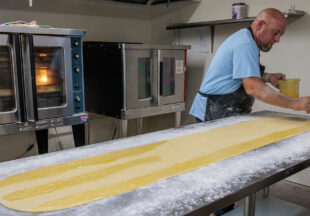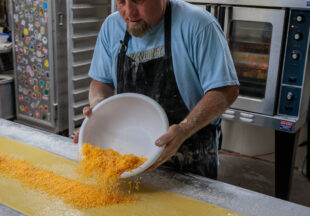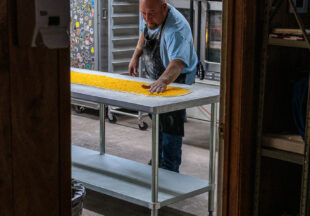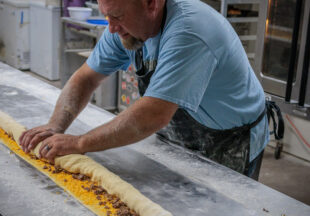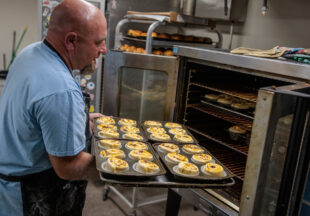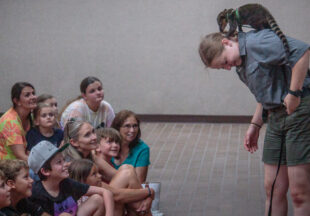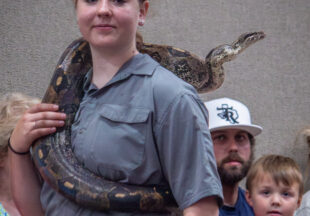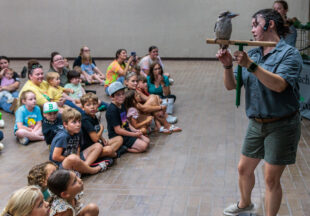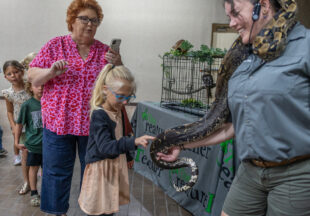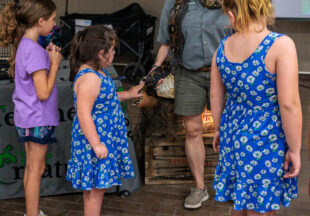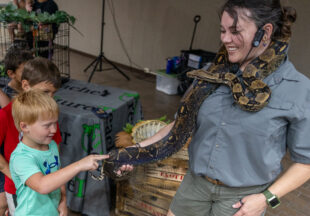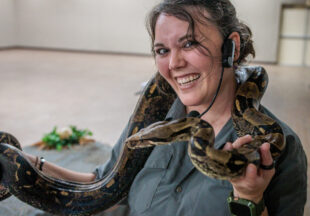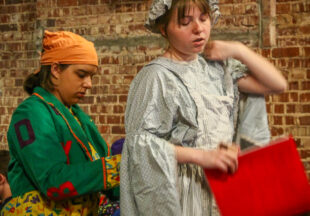Looking into the eyes of evil: The day I covered the execution of Texas’ infamous Halloween killer
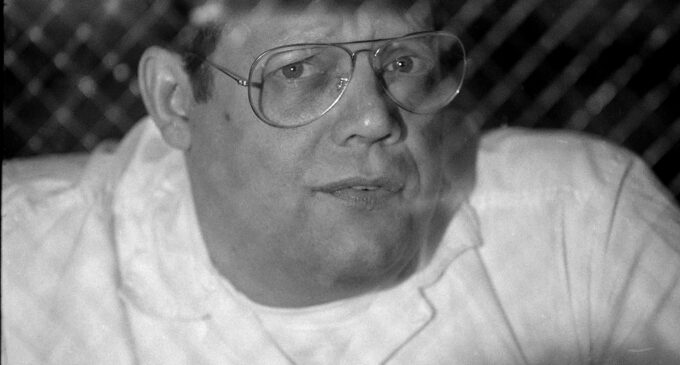
Breckenridge Texan Publisher Tony Pilkington takes a look back at his coverage of the execution of convicted child killer Ronald Clark O’Bryan, aka the Candy Man, who killed his own son on Halloween night in 1974.
By Tony Pilkington/Breckenridge Texan
For me, the story of child murderer Ronald Clark O’Bryan, aka “The Candy Man,” is a two-part story that changed Halloween forever.
It’s a story that started when I was just a kid and concluded when I was a young adult covering death row as a photojournalist. But, the effects of the 1974 tragedy linger in today’s cautious parents and grandparents who strive to keep their children safe on Halloween.
THE TIMES
Growing up, Halloween was one of my favorite holidays. What was not to love? You got to dress up in a costume and scour the neighborhood in search of free candy.
Mostly, we weren’t very imaginative with our costumes back then. We just made them ourselves, with a hobo being the most popular costume. It was simple. You just found an old pair of torn play-clothes, jeans and a t-shirt with holes in it, then used an eyebrow pencil to draw a beard on your face. We carried our candy stash in a large brown paper grocery bag.
Although I grew up in Houston, we lived in a suburban neighborhood on the outskirts of the city and pretty much stuck to that neighborhood when trick-or-treating. Our neighborhood was plenty big enough to get a full bag of candy, so we stayed close to home.
We knew most of the kids we encountered while trick-or-treating and were familiar with most of the families who lived in our neighborhood. When you knocked on the door and yelled “trick or treat,” it was usually a parent of one of your friends who answered the door or maybe an older teenage kid who was too cool to be seen trick-or-treating.
We felt safe in our little trick-or-treat world. Oh sure, we had all heard the old warnings about kids getting razor blades in their apples or poisoned candy, but we didn’t worry about it. In fact, I can’t ever remember anybody giving me an apple. I wonder if parents made up most of those old stories to keep kids from straying too far or eating too much candy along the way. Dads probably used it as a ruse to get first shot at all the best chocolate candy bars their kids brought home.
But then it really happened, and Halloween changed forever. An 8-year-old boy received a giant Pixy Stix that contained cyanide and died on Halloween night. And what made it worse for me and my friends was that it happened right there in the Houston area.
THE MURDER
The story of what took place on Oct. 31, 1974, in Pasadena, Texas, is one of unimaginable greed and one that strikes fear into the hearts of parents, even today, almost 50 years later.

Convicted child-killer Ronald Clark O’Bryan pauses as he fields questions from reporters during a meeting with media representatives a couple of days before his execution for killing his son. (Photo by Tony Pilkington/Breckenridge Texan)
According to various news reports, Ronald Clark O’Bryan was deeply in debt and had purchased four insurance policies on his two children, 8-year-old Timothy and 5-year-old Elizabeth. His wife would testify at his trial that she was unaware of the two larger policies or of O’Bryan’s apparent murderous plans.
On Halloween night, O’Bryan took the children from their home in Deer Park to a neighborhood in nearby Pasadena to go trick-or-treating with a family friend and his kids. One house the group visited was dark and no one answered the door. As the kids moved on, O’Bryan stayed behind, allegedly to see if anyone was home. He claimed that a man whose face he did not see had opened the door and given him Pixy Stix candy for the children. He gave the tubes filled with flavored sugar to five children, including his own.
Back home, Timothy struggled to open his Pixy Stix, which had been stabled shut. His dad helped him open the package, and Timothy tasted the powder. He complained that it tasted bitter, so O’Bryan gave him some Kool-Aid to drink. A short time later, Timothy was pronounced dead at the hospital, news reports say.
THE IMPACT
Even in a city the size of Houston, people were shocked by the murder. It was a huge crime. The police quickly identified the cause of death as cyanide poisoning and the source of the poison as the Pixy Stix.
As the police went nuts looking for the person that did it, families across Texas and beyond were told not to eat any Pixy Stix candy. I was already 15 by that Halloween, so I wasn’t out getting candy from the neighbors, but my younger siblings certainly were.
Quickly, the police located the other four candies that O’Bryan had handed out; they were unopened, and the other children were safe.
During the investigation, all of O’Bryan’s excuses and explanations were discredited, and he was arrested for the murder of his own son. At the trial, the prosecution claimed that he had researched cyanide and doctored the candy, planting the additional Pixy Stix candies to throw the cops off his trail.
O’Bryan maintained his innocence, but the jury took less than an hour to convict him and 71 minutes to sentence him to death.
It was a real horror story that would change Halloween forever, not just for me but for everyone for years to come.
THE EYES
The story would pick up again for me in a more personal way a decade later when I was in college. After his conviction, O’Bryan, or “The Candy Man” as he came to be called, was set to be executed by lethal injection in March 1984, and I found myself looking directly into the eyes of a killer.
I was a senior journalism student at Sam Houston State University in Huntsville at the time and was working as a staff photographer for the Huntsville Morning News. I was assigned to go with one of our reporters to interview and shoot photos of O’Bryan a few days before he was to be executed.
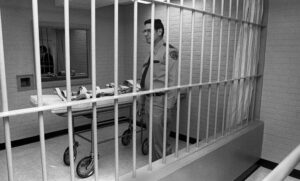
A correctional officer in the Texas Prison Death House stands near the gurney where condemned inmates were strapped in and given a lethal injection. (Photo by Tony Pilkington/ Breckenridge Texan)
By that time, I had covered many stories inside the prison system and photographed many inmates during my years in Huntsville. I also had covered the drama between the pro and con death penalty protesters who showed up on execution days. Things had really heated up since Texas had restarted executions less than two years earlier when they executed Charles Brooks, Jr., the first Texas inmate to die from lethal injection.
But, when I photographed O’Bryan, it was my first trip to Ellis Unit I, which at the time was where Texas Death Row inmates were incarcerated. I would make other trips in the coming months to shoot photos of other condemned inmates, but this was by far the most memorable.
The Ellis I unit was located several miles from Huntsville out in the middle of the East Texas piney woods. It was a maximum security prison, and it was also where all the death row inmates were housed until right before their execution when they were transferred to the Walls Unit in downtown Huntsville, where the death house was located. Back then, they were usually transferred to Huntsville in the early morning hours on the day before their execution, which would take place shortly after midnight the next day.
They would spend their last hours alive in one of the small cells down the hall from the execution room. Then, they would be taken down the hall and strapped to a gurney and put to death. There was a small seating area for witnesses to sit and watch the execution. Usually, that included the victims’ families, the condemned man’s own relatives, law enforcement officers who had worked the case and/or members of the media. Years earlier, it was the room where the electric chair, aka “Old Sparky,” was located.
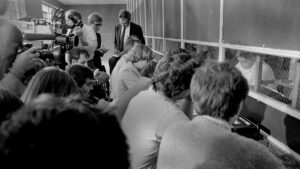
Members of the media crowd around Ronald Clark O’Bryan as he fields questions in the visitation room at the Ellis I Prison where Texas Death Row inmates were incarcerated. (Photo by Tony Pilkington/Breckenridge Texan)
When the Huntsville Morning News reporter and I arrived in the visiting room to interview O’Bryan, the place was packed. There were TV cameras set up, and reporters crowded around the glass window where O’Bryan was seated to answer questions.
I remember being surprised by how many media outlets had turned out to interview him, but I guess I shouldn’t have been. The murder had been a huge story, and O’Bryan’s pending execution was a big story that had attracted national and international attention. The two earlier Texas executions by lethal injection had drawn a large amount of attention, as well. I met news crews from as far away as Japan that were there to cover the stories.
One of the first things I noticed about O’Bryan was how well spoken he was compared to so many of the other prison inmates I had covered. He appeared more educated and more literate than most inmates I had met.
And he was working the room.
With all the reporters and cameras gathered around him, he was doing his best to convince them of his innocence. As strange, or as bizarre it was, O’Bryan seemed as comfortable as any politician or PR person I had covered, fielding questions at a press conference. And, his eyes, like his demeanor, were cold and steely as he stared at the reporters on the other side of the window.
I don’t exactly remember what he said anymore, but mostly I remember O’Bryan’s confidence and comfort in saying it. To me, he seemed like a man who had been locked up in a prison cell for so long that he had convinced himself that he didn’t do it. I’ll guess I’ll never know if he really believed his own story or if it was just part of his tactic.
Then, there were the little things I noticed. For example, he was wearing glasses, yet he had another pair of glasses in his shirt pocket, along with several pens, and another pair on the shelf next to the window where he was sitting. Maybe it had something to do with the fact that he had been working as an optician at Texas State Optical when he murdered his son.
Another thing about O’Bryan that was different from many of the other inmates who died in prison, including those who were executed, was that he already had made arrangements for a private funeral and burial in a cemetery in Deer Park. Back then, many of the others were buried at the Captain Joe Byrd Prison Cemetery in Huntsville with a white cross on their grave with just a number – no name.
As I took photos, I studied O’Bryan’s face and couldn’t help but think, “Here’s a man who will be dead soon.” I knew exactly where he was headed. I had been in the death house where he was going, and it was no game. Maybe he was just a man who knew exactly what he had done and was making one final play to save his life.
But, to me, he was serving up one of the worst injustices he could to his son, trying to continue to claim his innocence instead of asking his family and the world to somehow forgive him. And not only did he take his own son’s life, but he stole so much from the rest of us, too, when he tarnished the innocence and fun of Halloween.
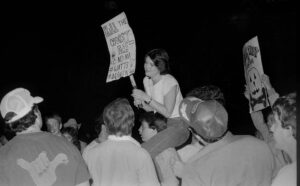
Pro-death penalty supporters hold signs outside the Walls Prison Unit as they wait to hear word that Ronald Clark O’Bryan had been executed. Protestors against the death penalty also were there to show their opposition. (Photo by Tony Pilkington/Breckenridge Texan)
A couple of days later, I was outside the Death House, taking photos of the protestors and counter-protestors gathered outside. It was a scene of contrasts, with nuns and other anti-death penalty protestors one one side, praying for O’Bryan, and the pro-death penalty on the other side, holding up Halloween-themed signs and waving Pixy Stix. After the execution, the crowd was informed that O’Bryan was dead, and everyone dispersed.
Over a couple of years’ time, I met and photographed several inmates on death row, some less than 24 hours before they died, and most were not nice people. But the Candy Man will always be at the top of my list of bad men. A man who would kill his own child for money is just pure evil.
LINGERING EFFECTS
Despite widespread reports that no other child has ever died from poisoned Halloween candy, parents continue, even over 40 years later, to check their children’s candy to make sure it hasn’t been tampered with.
And, although I know the truth behind the story, I’ll admit that, as a dad taking his little girl trick-or-treating in Breckenridge just a few years ago, I never was too comfortable with her getting Pixy Stix for Halloween.
Through the years, I suppose, we’ve all adapted and learned to balance our trust in our neighbors with a healthy dose of caution. And, although it does take some of the innocence out of Halloween, especially for the adults, I guess it’s something we should all continue to do, to make sure the kids are safe.
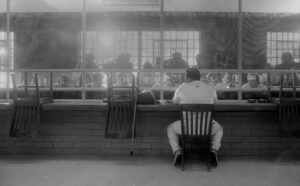
Ronald O’Bryan faces reporters and cameras as he fields questions from the media in the visitation area of the Ellis I Unit shortly before his execution for killing his son. (Photo by Tony Pilkington/Breckenridge Texan)
Cutline, top photo: Ronald Clark O’Bryan, who murdered his 8-year-old son Timothy on Halloween in 1974, stares into the lens of photographer Tony Pilkington during an interview with the media in the visitation room at the Ellis I Prison unit . (Photo by Tony Pilkington/Breckenridge Texan)
Make sure you don’t miss any of the Breckenridge Texan’s news…click here to sign up for our email newsletter, the Weekly News Roundup. It has links to stories, photo galleries and more! It’s free to sign up, and it comes to you on Monday mornings (Tuesdays, after a holiday).











